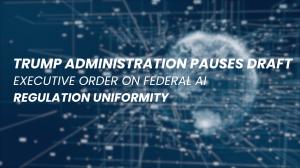Trump Administration Pauses Draft Executive Order On Federal AI Regulation Uniformity
Trump administration paused draft EO for uniform federal AI regulation, seeking preemption of state laws, highlighting regulatory uncertainty for US innovation.
WASHINGTON, DC, UNITED STATES, November 28, 2025 /EINPresswire.com/ -- The Trump Administration has temporarily paused the release of a draft executive order (EO) designed to establish a unified national framework for Artificial Intelligence (AI) regulation. The draft order—titled “Advancing American AI Leadership Through Federal Uniformity”—was expected to centralize AI governance authority at the federal level, but internal debate and resistance from state officials have delayed its publication.The pause arrives at a moment of intensifying regulatory fragmentation. More than 1,000 AI-related bills have been introduced across U.S. state legislatures in 2025, creating a complex landscape for Chief AI Officers (CAIOs), compliance teams, and business leaders deploying high-stakes AI systems. Many organizations had hoped that a federal uniformity order would provide a clearer path forward.
The draft EO sought to preempt conflicting state regulations and establish a more predictable regulatory environment. Provisions under consideration reportedly included empowering the Attorney General to create an AI Litigation Task Force to challenge state laws that could hinder national competitiveness. Other elements would have allowed the federal government to influence state compliance through grant funding incentives, while directing agencies such as the Commerce Department and Federal Trade Commission (FTC) to identify problematic state requirements and issue guidance on AI-related competition concerns.
Supporters argue that a patchwork of state policies increases compliance costs, slows R&D investments, and complicates the rollout of advanced technologies like agentic and multimodal AI. Some analysts estimate that, without federal standardization, AI governance costs in the U.S. could approach $1 billion by 2030. Industry leaders have emphasized the need for regulatory certainty to maintain global competitiveness, especially amid rapid advancements from international rivals.
However, the proposed federal preemption has also faced strong criticism. Safety advocates and state policymakers warn that suspending or overriding state laws before robust national standards are in place could create a “regulatory vacuum.” They argue that aggressive preemption may weaken safeguards intended to protect consumers from emerging AI risks such as algorithmic bias, misinformation, deepfakes, and job displacement. States like California and Colorado—whose new laws address hiring bias and high-risk AI transparency—have voiced particular concern that preemption could limit their ability to defend residents from harm.
With the EO’s timeline now uncertain, organizations across the country must continue navigating state-level requirements while preparing for potential federal shifts. Compliance pressures remain especially acute for businesses operating in jurisdictions with near-term enforcement deadlines.
“While the pause introduces new uncertainty, our commitment to responsible and transparent AI does not change,” said a company spokesperson. “Clear, consistent policies benefit everyone—from innovators to consumers—and we will continue to invest in strong governance, human oversight, and robust risk management regardless of how the regulatory landscape evolves.”
AI policy experts recommend that organizations use this window to perform fresh risk audits, evaluate exposure under existing state laws, and strengthen internal AI governance frameworks to ensure readiness for future federal action. With national standards still under negotiation, proactive preparation remains essential.
As the Administration works to reconcile innovation goals with public safety considerations, business and technology leaders await further guidance on what could become the nation’s most consequential AI regulatory shift to date.
Author
Sanjay Puri
President, Knowledge Networks
Upasana Das
Knowledge Networks
email us here
Visit us on social media:
LinkedIn
Instagram
Facebook
YouTube
X
Legal Disclaimer:
EIN Presswire provides this news content "as is" without warranty of any kind. We do not accept any responsibility or liability for the accuracy, content, images, videos, licenses, completeness, legality, or reliability of the information contained in this article. If you have any complaints or copyright issues related to this article, kindly contact the author above.

